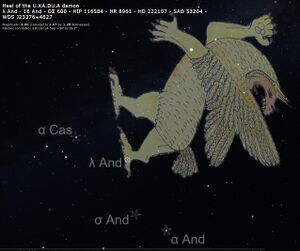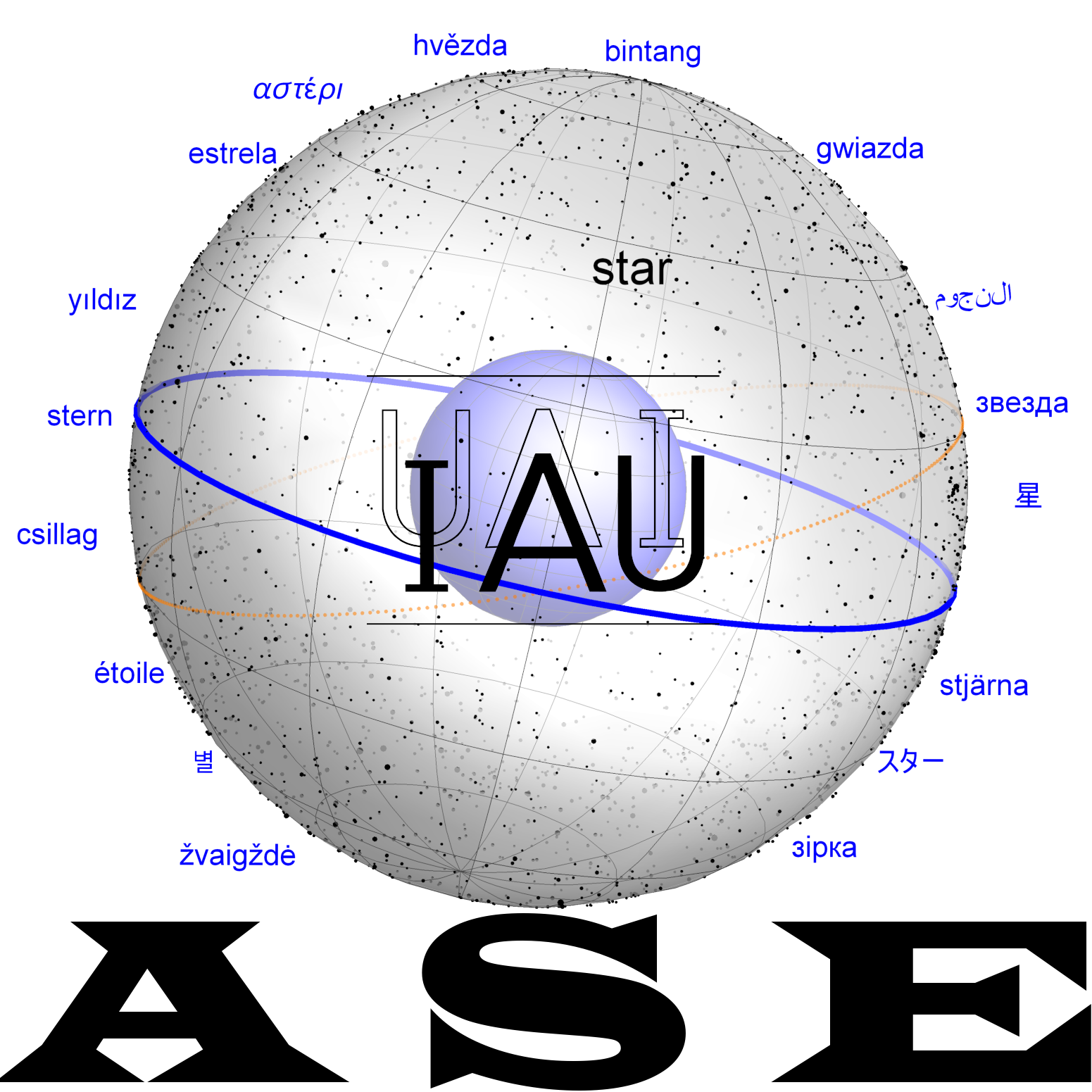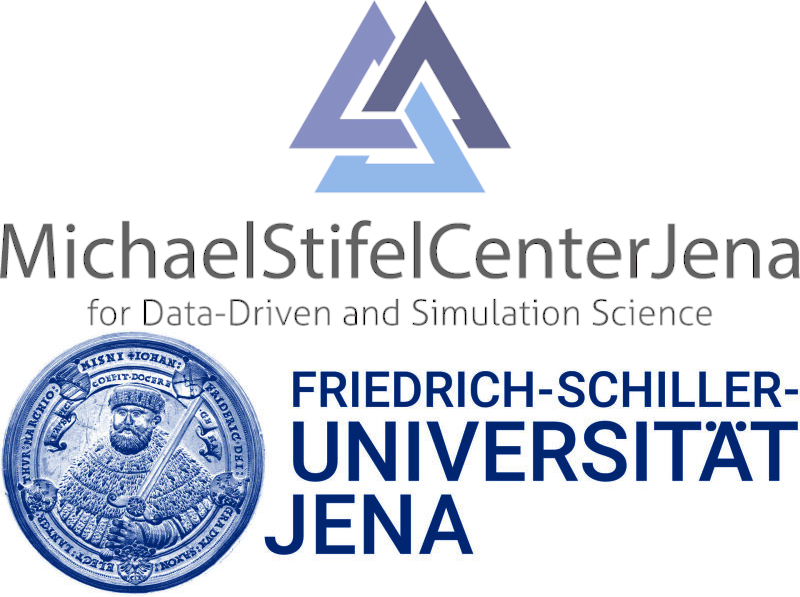Asidu: Difference between revisions
DavidHilder (talk | contribs) No edit summary |
No edit summary |
||
| (11 intermediate revisions by 2 users not shown) | |||
| Line 1: | Line 1: | ||
{{DISPLAYTITLE:Asīdu}} |
{{DISPLAYTITLE:''Asīdu''}} |
||
[[File:Heel of UKADUA.jpg|alt=Stellarium map|thumb|Heel of the "Demon with the Gaping Mouth" in Mesopotamian astral science, typically identified with lambda Andromedae (in the first millennium). Depiction in Stellarium, painting by Jessica Gullberg 2021.]] |
[[File:Heel of UKADUA.jpg|alt=Stellarium map|thumb|Heel of the "Demon with the Gaping Mouth" in Mesopotamian astral science, typically identified with lambda Andromedae (in the first millennium). Depiction in Stellarium, painting by Jessica Gullberg 2021.]] |
||
The body part |
The body part ''asīdu'' (𒀀𒋛𒁺) is the heel of human figures and parallel part in composites. For the asidu as part of any constellation see those entries. |
||
==Concordance, Etymology, History== |
|||
==Dictionary (Provenance of the term)== |
|||
===Kurtik with Hilder, Hoffmann, Horowitz, Kim=== |
===Kurtik with Hilder, Hoffmann, Horowitz, Kim=== |
||
= <sup>mul</sup>Asīdu "Heel" is used as designation for a body part of constellations [G. 38; AHw 73-74; CAD A/2, 330], including: |
= <sup>mul</sup>''Asīdu'' "Heel" is used as designation for a body part of constellations [G. 38; AHw 73-74; CAD A/2, 330], including: |
||
# Heel of <sup>mul</sup>[[UD.KA.DU8.A|UD.KA. |
# Heel of <sup>mul</sup>[[UD.KA.DU8.A|UD.KA.DU<sub>8</sub>.A]] (The Demon with the Gaping Mouth): '''λ And''' |
||
# Heel of Enmesharra, see (Kurtik e11) [[EN.ME.ŠAR2.RA|EN.ME.ŠAR<sub>2</sub>.RA]], V 2. |
# Heel of Enmesharra, see (Kurtik e11) [[EN.ME.ŠAR2.RA|EN.ME.ŠAR<sub>2</sub>.RA]], V 2 ('''ζ Per'''<sup>?</sup>, ι Aur would also be possible - within Mesopotamian uranography, there is no argument against it, except for the proposed identification of The Old Man with Greek Perseus).. |
||
# Heel of the Old Man, see (Kurtik sh16) [[ŠU.GI]], (Kurtik e11) [[EN.ME.ŠAR2.RA|EN.ME.ŠAR<sub>2</sub>.RA]], III 4. |
# Heel of the Old Man, see (Kurtik sh16) [[ŠU.GI]], (Kurtik e11) [[EN.ME.ŠAR2.RA|EN.ME.ŠAR<sub>2</sub>.RA]], III 4 ('''ζ Per'''<sup>?</sup>). |
||
# The Rear Heel of the True Shepherd of Anu, see (Kurtik s22) [[SIPA.ZI.AN.NA]], V 1. |
# The Rear Heel of the True Shepherd of Anu, see (Kurtik s22) [[SIPA.ZI.AN.NA]], V 1 (GU-text: '''η Lep''')<ref>Hoffmann, S.M. (2022). Astronomical Information in the GU-Text, in Hoffmann and Wolfschmidt (eds.). Astronomy in Culture – Cultures of Astronomy, tredition Hamburg/ OpenScienceTechnology Berlin, 193-204</ref>. |
||
The "heel of UD.KA. |
The "heel of UD.KA.DU<sub>8</sub>.A" is a ''ziqpu''-star (= ''ziqpu'' XI, in the constellation of Andromeda) and has, thus, a metrical significance. |
||
{| class="wikitable" |
{| class="wikitable" |
||
! scope="col" style="width: 70%;" |Sources |
|||
! |
! scope="col" style="width: 30%;" |Identifications |
||
|- |
|- |
||
|'''MUL.APIN.''' |
|'''MUL.APIN.''' |
||
| Line 22: | Line 22: | ||
** "On the 10th of Simanu the Heel of the Demon with a Gaping Mouth stands in the middle of the sky / opposite your chests, and the True Shepherd of Anu ascends" (I iv 19-20) [MA 63]. |
** "On the 10th of Simanu the Heel of the Demon with a Gaping Mouth stands in the middle of the sky / opposite your chests, and the True Shepherd of Anu ascends" (I iv 19-20) [MA 63]. |
||
| |
| |
||
* . |
|||
** λ And |
|||
** λ And |
|||
|- |
|- |
||
|'''Lists of ziqpu-stars.''' |
|'''Lists of ziqpu-stars.''' |
||
* (1) AO 6478: |
* (1) AO 6478: |
||
** a) |
|||
** a) [3 ⅓] MA.NA MIN(=''šuqultu'') | ⅔ DANNA ''i-na'' KI.MIN (= ''ina qaqqari'') | 36 IGI DANNA ''ina'' [KI. MIN] (= ''ina šamê'') / TA <sup>mul</sup>''kin-ṣi'' EN <sup>mul</sup>''a-si''-[''di''] "[3⅓] mins weight, 20° on earth, 36000 miles in the sky / From Knee to Heel (Demon with the Gaping Mouth)", |
|||
** |
*** [3 ⅓] MA.NA MIN(=''šuqultu'') | ⅔ DANNA ''i-na'' KI.MIN (= ''ina qaqqari'') | 36 IGI DANNA ''ina'' [KI. MIN] (= ''ina šamê'') / TA <sup>mul</sup>''kin-ṣi'' EN <sup>mul</sup>''a-si''-[''di''] |
||
* |
*** "[3⅓] mins weight, 20° on earth, 36000 miles in the sky / From Knee to Heel (Demon with the Gaping Mouth)", |
||
** b) |
|||
| ⚫ | |||
*** [1⅔ M]A. NA MIN | 10 UŠ ''i-na'' KI.MIN | 18 IGI DANNA i[na KI.MIN] (=ina šamê) / TA <sup>mul</sup>''a-si-di'' EN IV ša<sub>2</sub> <sup>mul</sup>LU.[LIM] |
|||
*** "[1⅔ mi]ns of weight, 10° on earth, 18000 miles in the sky / From Heel to 4 stars of the Dee[r]" [Thureau-Dangin 1913, 216:23-26; TU, 21:23-26; HBA, 132; Schaumberger 1952, 228-229]; for a parallel see. [CT 26, 50, K. 9794:14-15]. |
|||
* (2) VAT 16437: |
|||
** ⅔ DANNA ''a-na mula-si-''[''du''] |
|||
** "20° to the Heel (of the Demon with an Open Mouth)." [Schaumberger 1952, 224-225:6]. |
|||
* (3) VAT 16436: |
|||
** <sup>múl</sup>''a-si-du'' // 1 // 8 IGI 2 ME KUŠ<sub>3</sub> |
|||
| ⚫ | |||
* (4) BM 38369+: |
* (4) BM 38369+: |
||
** a) TA <sup>d</sup>''ki-in-ṣi-šu'' EN ''a-si-di-šu''<sub>2</sub> ˹⅔˺ [DANNA] "From his Knee to his Heel ⅔ [miles]," |
** a) TA <sup>d</sup>''ki-in-ṣi-šu'' EN ''a-si-di-šu''<sub>2</sub> ˹⅔˺ [DANNA] "From his Knee to his Heel ⅔ [miles]," |
||
** b) TA ''da-si-di-šu'' EN SI ''ša'' <sup>mul</sup>LU.[LIM ...] "From his Heel to the |
** b) TA ''da-si-di-šu'' EN SI ''ša'' <sup>mul</sup>LU.[LIM ...] "From his Heel to the Horns of the Sta[g]..." [Horowitz 1994a, 91-92:5-7]. |
||
* (5) Sippar Planisphere: |
* (5) Sippar Planisphere: |
||
** ⅔ DANNA ana <sup>mul</sup>''a-si-du'' |
** ⅔ DANNA ana <sup>mul</sup>''a-si-du'' |
||
** "⅔ miles (200) to (his) Heels" [Horowitz-al-Rawi 2001, 171-173:11]. |
** "⅔ miles (200) to (his) Heels" [Horowitz-al-Rawi 2001, 171-173:11]. |
||
| |
| |
||
* (1) |
|||
** (a) λ And |
|||
** (b) λ And |
|||
* (2) λ And |
|||
* (3) λ And |
|||
* (4) |
|||
** (a) λ And |
|||
** (b) λ And |
|||
* (5) |
|||
** λ And |
|||
** λ And |
|||
|- |
|- |
||
|'''Anaphora.''' |
|'''Anaphora.''' |
||
| Line 42: | Line 64: | ||
** TA ''a-si-du'', see (Kurtik a21) [[ALLA]]. |
** TA ''a-si-du'', see (Kurtik a21) [[ALLA]]. |
||
| |
| |
||
* λ And |
|||
* λ And |
|||
|- |
|- |
||
|'''"Astronomical Diaries and Related Texts.”''' |
|'''"Astronomical Diaries and Related Texts.”''' |
||
* <sup>múl</sup>''a-si-du ziq-pi sin'' AN.KU<sub>10</sub> "(When) the Heel culminated, the eclipse of the Moon (took place)." [AD III, no.-90 obv. 6]. Calendar of daily risings and settings of the ''ziqpu''-star. See. [Schaumberger 1955, 247-251]. |
* <sup>múl</sup>''a-si-du ziq-pi sin'' AN.KU<sub>10</sub> "(When) the Heel culminated, the eclipse of the Moon (took place)." [AD III, no.-90 obv. 6]. Calendar of daily risings and settings of the ''ziqpu''-star. See. [Schaumberger 1955, 247-251]. |
||
|λ And |
|||
| |
|||
|} |
|} |
||
See also: |
See also: |
||
| Line 110: | Line 134: | ||
[[Category:Eurasia]] |
[[Category:Eurasia]] |
||
[[Category:Cuneiform]] |
[[Category:Cuneiform]] |
||
[[Category:4work]] |
|||
Latest revision as of 17:58, 16 August 2025
The body part asīdu (𒀀𒋛𒁺) is the heel of human figures and parallel part in composites. For the asidu as part of any constellation see those entries.
Concordance, Etymology, History
Kurtik with Hilder, Hoffmann, Horowitz, Kim
= mulAsīdu "Heel" is used as designation for a body part of constellations [G. 38; AHw 73-74; CAD A/2, 330], including:
- Heel of mulUD.KA.DU8.A (The Demon with the Gaping Mouth): λ And
- Heel of Enmesharra, see (Kurtik e11) EN.ME.ŠAR2.RA, V 2 (ζ Per?, ι Aur would also be possible - within Mesopotamian uranography, there is no argument against it, except for the proposed identification of The Old Man with Greek Perseus)..
- Heel of the Old Man, see (Kurtik sh16) ŠU.GI, (Kurtik e11) EN.ME.ŠAR2.RA, III 4 (ζ Per?).
- The Rear Heel of the True Shepherd of Anu, see (Kurtik s22) SIPA.ZI.AN.NA, V 1 (GU-text: η Lep)[1].
The "heel of UD.KA.DU8.A" is a ziqpu-star (= ziqpu XI, in the constellation of Andromeda) and has, thus, a metrical significance.
| Sources | Identifications |
|---|---|
MUL.APIN.
|
|
Lists of ziqpu-stars.
|
|
| Anaphora. |
|
"Astronomical Diaries and Related Texts.”
|
λ And |
See also:
- TA kin-ṣi-šu2 EN a-si-di-šu2
- "From its (the Demon with an Open Mouth) knee to its heel" [TCL 6, 18 r. 15];
- a-na a-si-du [LBAT, 1501:10];
- EN a-si-di [mul]En-me-šar2-ra
- "to the heel of Enmesharra" [ACh Suppl. 2, 53 r. 15];
- múla-[si-du] [Sachs 1952, 75, U. 197:9′].
Additional
II. Identification.
Ziqpu XI:
= α Andromedae [G. 38];
= múla-si-du includes 1 star, according to VAT 16436:3; = σ Andromedae(?) [Schaumberger 1952, 227-227, 229];
= α Cassiopeiae [MA 143];
= λ Andromedae [ASM 86, 275].
Historical Dictionaries
| Kurtik (2022, a47) | Gössmann (1950) |
|---|---|
| = «Пятка (Демона с Разинутой Пастью)»; 1) = ziqpu XI, звезда в созвездии Андромеды (Andromeda), 2) элемент фигуры ряда созвездий [G. 38; AHw 73–74; CAD A/2, 330]. | Example |
| MUL.APIN. В списке кульминаций и одновременных гелиакических восходов: ina itiSIG4 UD 10 KAM a-si-du ša2 mulUD.KA.DUḪ.A ina MURUB4 AN-e / IGI-it GABA-ka GUB-ma mulSIPA.ZI.AN.NA KUR-ḫa «10-го симану Пятка Демона с Разинутой Пастью стоит в середине неба / напротив твоей груди, и Праведный Пастух Ану восходит» (I iv 19–20) [MA 63]. Списки ziqpu-звезд. (1) AO 6478: a) [3 ⅓] MA.NA MIN(=šuqultu) | ⅔ DANNA i-na KI.MIN (= ina qaqqari) | 36 IGI DANNA ina [KI.MIN] (= ina šamê) / TA mulkin-ṣi EN mula-si-[di] «[3⅓] мины веса, 200 на земле, 36000 миль на небе / От Колена до Пятки (Демона с Разинутой Пастью)», b) [1⅔ M]A.NA MIN | 10 UŠ i-na KI.MIN | 18 IGI DANNA i[na KI.MIN] (=ina šamê) / TA mula-si-di EN IV ša2 mulLU.[LIM] «[1⅔ ми]ны веса, 100 на земле, 18000 миль на небе / От Пятки до 4 звезд Оле[ня]» [Thureau-Dangin 1913, 216:23–26; TU, 21:23–26; HBA, 132; Schaumberger 1952, 228–229]; параллель см. [CT 26, 50, K. 9794:14–15]. (2) VAT 16437: ⅔ DANNA a-na mula-si-[du] «200 до Пятки (Демона с Разинутой Пастью)» [Schaumberger 1952, 224–225:6]. (3) VAT 16436: múla-si-du // 1 // 8 IGI 2 ME KUŠ3 «Пятка // 1 (звезда) // 8200 локтей» [Schaumberger 1952, 226–227:3]. (4) BM 38369+: a) TA dki-in-ṣi-šu EN a-si-di-šu2 ˹⅔˺ [DANNA] «От его Колена до его Пятки ⅔ [мили]», b) TA da-si-di-šu EN SI ša mulLU.[LIM …] «От его Пятки до Рога Оле[ня]…» [Horowitz 1994а, 91–92:5–7]. (5) Sippar Planisphere: ⅔ DANNA ana mula-si-du «⅔ мили (200) до (его) Пятки» [Horowitz–al-Rawi 2001, 171–173:11]. Анафора. BM 36609+: EN a-si-du, см. m15MAŠ.MAŠ; TA a-si-du, см. a21ALLA. «Дневники наблюдений». múla-si-du ziq-pi sin AN.KU10 «(Когда) Пятка кульминировала, затмение Луны (имело место)» [AD III, No.-90 obv. 6]. Kалендарь ежедневных восходов и заходов ziqpu-звезд. См. [Schaumberger 1955, 247–251].
Cм. также: TA kin-ṣi-šu2 EN a-si-di-šu2 «От его (Демона с Разинутой Пастью) колена до его пятки» [TCL 6, 18 r. 15]; a-na a-si-du [LBAT, 1501:10]; EN a-si-di [mul]En-me-šar2-ra «до пятки Энмешарры» [AСh Suppl. 2, 53 r. 15]; múla-[si-du] [Sachs 1952, 75, U. 197:9′]. II. Отождествление. Ziqpu XI: = α Andromedae [G. 38]; = múla-si-du включало 1 звезду, согласно VAT 16436:3; = σ Andromedae(?) [Schaumberger 1952, 227–227, 229]; = α Cassiopeiae [MA 143]; = λ Andromedae [ASM 86, 275]. Как элемент фигуры созвездия: (1) Пятка Энмешарры, см. e11EN.ME.ŠAR2.RA, V 2. (2) Задняя пятка Праведного Пастуха Ану, см. s22SIPA.ZI.AN.NA, V 1. (3) Пятка Старика, см. sh16ŠU.GI, e11EN.ME.ŠAR2.RA, III 4. |
Example |
References
- ↑ Hoffmann, S.M. (2022). Astronomical Information in the GU-Text, in Hoffmann and Wolfschmidt (eds.). Astronomy in Culture – Cultures of Astronomy, tredition Hamburg/ OpenScienceTechnology Berlin, 193-204





